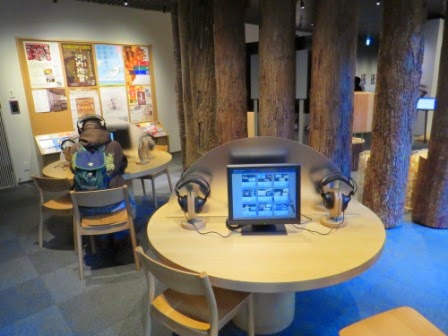The new Takenaka Carpentry Museum
I had never visited the former Takenaka Dougu Kan (Carpentry Tools Museum) but I just spent a couple hours at the brand new one in Shinkobe, Japan. The museum has also updated their English webpage (http://www.dougukan.jp/) to reflect the new facility, exhibits, and events. I did not interview any officials there, so these are purely my observations.
I will readily say this is a first rate facility designed for a broad audience and worth a trip if you are ever nearby. Getting there was relatively easy - take the Sanyo Shinkansen line. The museum property is within several hundred yards of the Shin-kobe Station. You walk out the main entrance doors of the station and take a left. See the website for a map. Admission is 500 yen for adults, less for students and seniors, free for children.
If it is not obvious from my iPhone pictures, this is a beautiful building and setting. A lot of traditional handiwork and thought went into it's creation.
You enter the museum on the first floor. The other two floors are downstairs (B1 and B2).
As you enter, a reception desk will be on your right, but this view of the lobby may draw your attention:
Floor 1 (Lobby) contains a dynamic set of exhibits that are likely to change regularly. During my visit there were examples of Korean, Chinese, and Japanese architecture and tools displayed with some nice examples of each. While an effort has been made to include English descriptions on the displays, the detailed explanations are mostly in Japanese, but it varies from display to display. There is also an English pamphlet that is provided upon admission.
 |
| View out the back window of the lobby. |
 |
| The stairs down from Lobby area. There is also an elevator. |
 |
| Actual notes of Nishioka Tsunekazu. |
 |
| Requisite tool kit. |
 |
| Timber forms and cross-sections. |
And of course the star of the show is the tools of the trade. B1 and B2 floors are loaded with hundreds of examples from legendary tool makers (and from some legendary toishi mines). The displays are mostly constructed in ways that facilitate photography and close-up viewing. You are not likely to be disappointed. The general setup for many of the tool displays is tools and descriptions above, and drawers of related examples below. Here are but a few.
 |
| Typical info panel, usually next to actual examples. |
 |
| Drawer of specialty planes. |
 |
| Drawer of toishi examples |
 |
| Drawer of specialty chisels. |
You can expect to view works of Chiyozuru Korehide, Sadahide, Taro, and Nobukuni. Saws by Oba, Miyano Tetsunosuke, Miyano Heijirou, Nakaya(s), Taniguchi, and others. Planes, chisels, and other tools by Usui Kengo, Hasegawa, Onishi, Zensaku, Hirosada, Ishido, and the list goes on (and on). This museum really has a vast collection. Not only are there physical examples on display, but there are also digitized images and write-ups on many tools (and other materials) not on display. You access these on terminals located throughout the museum, and you can choose the language on these.
Also on B2 are the classroom (shop), a small viewing/presentation area, and a multi-media area for watching (mostly Japanese, but very good) videos on such topics as sharpening, planing, joining, etc. Plus there are actual works of shokunin spread around - and there is the tea house. I think there is a both a tea house out back (open only during certain seasons) and the skeleton tea house in the basement (B2).
 |
| A small corner of an amazing kumiko panel. |
 |
| Presentation area. |
 |
| Video viewing stations. |
 |
| The shop classroom. |
 |
| And the tea house skeleton. |
The museum strives to be relevant and so has ongoing exhibits, classes, demonstrations, and lectures. As I was leaving a TV crew was setting up for some kind of event. So I definitely had the impression that all efforts were being made to promote the message of the museum, "connecting tradition and innovation."












Comments
7 Chome-5-1 Kumochichō Chūō-ku, Kōbe-shi, Hyōgo-ken 651-0056
TEL 078-242-0216
FAX 078-241-4713
-David